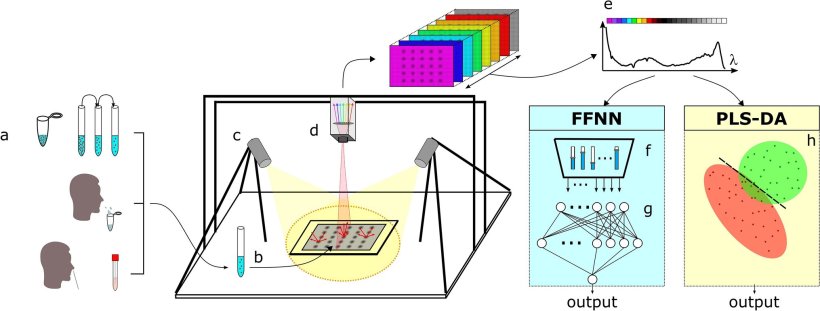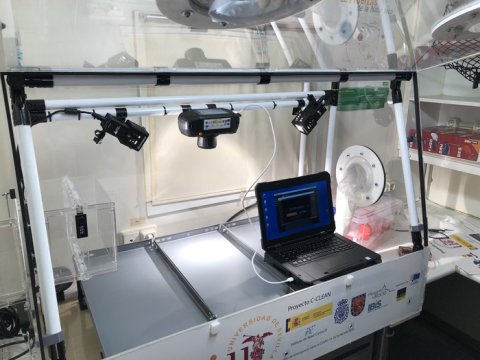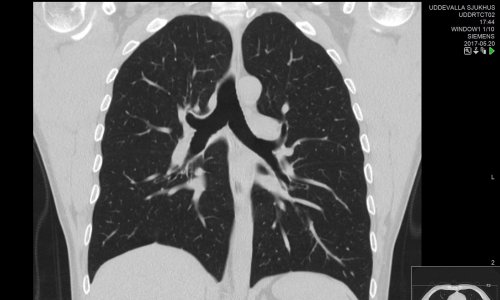
Credit: Emilio Gomez-Gonzalez et al, Optical imaging spectroscopy for rapid, primary screening of SARS-CoV-2: a proof of concept, Scientific Reports (2022). DOI: 10.1038/s41598-022-06393-3.
News • Adaptable for screening
An optical methodology for rapid detection of COVID-19
A team of Spanish researchers, coordinated by the University of Seville, has published the first results of an optical methodology for detecting the coronavirus that causes COVID-19. This tool could potentially be used for massive, fast and simple screening.
This new methodology has obtained a sensitivity of 100 percent and a specificity of 87.5 percent in the detection of SARS-CoV-2 in nasopharyngeal exudate (the same samples used in a PCR test) from symptomatic people. It also detected the presence of SARS-CoV-2 in fresh saliva of asymptomatic people, as well differentiating and quantifying two types of synthetic viruses (lentiviruses and synthetic coronaviruses) in two biofluids (saline solution and artificial saliva). The main advantage of this new technology over PCR lies in the speed of sample processing and the ability of the optical system to simultaneously analyze a large number of samples.
The authors of the study warn that these results should still be viewed with caution, as they constitute a proof of concept, involving a relatively small numbers of cases under partially controlled laboratory conditions. For this reason, they are currently working on validating this new methodology under generic conditions, including new variants of the virus and the effects of vaccines.

This new methodology allows for the detection of viruses in liquid droplets and dry residues deposited on surfaces, through hyperspectral imaging and data processing based on advanced statistics and artificial intelligence. It allows rapid processing of multiple samples simultaneously, without contact or reagents and with relatively simple equipment, usable by personnel with minimal training. This new technique uses standard optical equipment and has been developed so that it can be implemented in resource-constrained settings. The technique has been patented and the authors are studying various options to set it up quickly and affordably.
The method and its implementation were designed by Prof. Emilio Gomez-Gonzalez, Principal Investigator of the Project and Professor of Applied Physics at the ETSI Engineering School of the University of Seville, where he directs its Group of Interdisciplinary Physics (GFI), researcher at the Group of Applied Neuroscience of the Institute of Biomedicine of Seville (IBIS) and collaborator of the HUMAINT Project of the JRC.
The fundamentals of the method and its early results of application to the detection of another synthetic model of SARS-CoV-2 were published last August 2021 in the same journal. The C-CLEAN Project has been a great scientific and technological challenge that has been carried out in a very short time (15 months), since April 2020, in the extraordinarily difficult circumstances derived from the COVID-19 pandemic. It is a complex investigation in which the results have been subjected to a rigorous and prolonged evaluation (6 months).
The research are published in the journal Scientific Reports.
Source: University of Seville
23.02.2022











